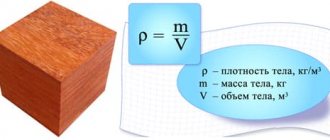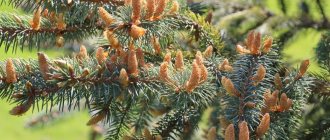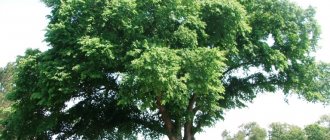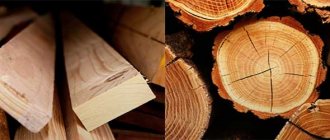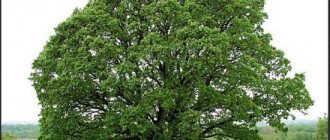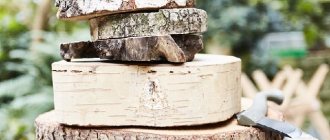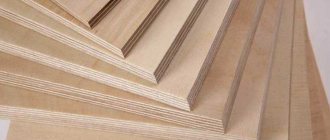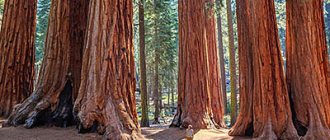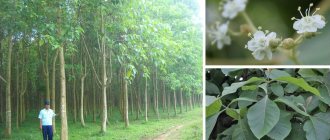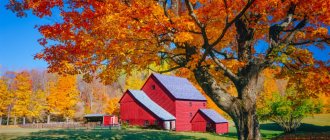In places of notches or connections of wooden parts with metal ones (under shoes, bolts, etc.), the strength of the wood when compressed across the fibers is of significant practical importance. A classic example of the work of wood in compression across the grain are also railway sleepers (places under the rails). There are three cases of wood compression across the grain:
1. The load is distributed over the entire surface of the compressed part.
2. The load is applied over part of the length, but across the entire width of the part.
3. The load is applied to parts of the length and width of the part.
All these cases occur in practice: the first case is when pressing wood, the second is when using sleepers under rails, the third is when using wood under the heads of metal fasteners. When compressed across the fibers of wood of different species, two types of deformation are observed: single-phase, as with compression along the fibers, and three-phase, characterized by a more complex diagram.
table of wood compressive strength along the grain
| Breed | Tensile strength, kg/cm2, with humidity | Breed | Tensile strength, kg/cm2, with humidity | ||
| 15% | 30% or more | 15% | 30% or more | ||
| Larch | 550 | 255 | Oak | 510 | 310 |
| Pine | 415 | 210 | Ash | 500 | 325 |
| Spruce | 390 | 195 | Walnut | 485 | 240 |
| Cedar | 360 | 185 | Beech | 475 | 260 |
| Siberian fir | 345 | 175 | Birch | 465 | 225 |
| White acacia | 665 | 415 | Elm | 405 | 250 |
| Hornbeam | 530 | 265 | Linden | 400 | 240 |
| Maple | 520 | 280 | Alder | 385 | 235 |
| Pear | 515 | 265 | Aspen | 375 | 190 |
| Poplar | 345 | 180 | |||
During single-phase deformation, the diagram clearly shows an approximately straight section, which continues almost until the maximum load is reached, at which the wood sample is destroyed. With three-phase deformation, the process of wood deformation during compression across the fibers goes through three phases: the first phase is characterized on the diagram by an initial, approximately straight section, showing that at this stage of deformation the wood conditionally obeys Hooke’s law, as with single-phase deformation; at the end of this phase the conditional limit of proportionality is reached; the second phase is characterized on the diagram by an almost horizontal or slightly inclined curved section; the transition from the first phase to the second is more or less abrupt; the third phase is characterized on the diagram by a straight section with a steep rise; the transition from the second phase to the third is gradual in most cases.
According to the nature of deformation during radial and tangential compression, rocks can be divided into two groups: the first group includes coniferous and ring-vascular deciduous species (with the exception of oak), and the second group includes diffuse-vascular deciduous species. Coniferous wood (pine, spruce) and ring-vascular hardwood (ash, elm) under radial compression gives a diagram characteristic of three-phase deformation, and under tangential compression - a diagram of single-phase deformation.
The noted nature of deformation of wood of the named species can be explained as follows. During radial compression, the deformation of the first phase occurs mainly due to compression of the early zone of the annual layers, which is mechanically weak; the first phase continues until the walls of the elements of the early zone lose stability and begin to collapse. With the loss of stability of these elements, the second phase begins, when deformation occurs mainly as a result of collapse of the elements of the early zone; this occurs at an almost constant or slightly increasing load. As elements of the late zone of annual layers are involved in deformation, the second phase smoothly passes into the third. The third phase occurs mainly due to compression of the elements of the late zone, consisting mainly of mechanical fibers, which can only wrinkle under heavy loads.
During tangential compression, deformation occurs from the very beginning due to the elements of both zones of the annual layer, and the nature of the deformation, naturally, is determined by the elements of the late zone. At the end of deformation, destruction of the sample occurs, which is more clearly expressed in coniferous wood: samples usually bulge towards the convexity of the annual layers, which, during tangential bending, behave like curved beams during longitudinal bending.
Among ring-vascular deciduous species, oak does not obey the noted patterns, the wood of which, under radial compression, is deformed according to a single-phase type, and under tangential compression it tends to switch to three-phase deformation. This is explained by the fact that during radial compression, wide core rays have a strong influence on the nature of deformation. During tangential compression, the tendency to transition to three-phase deformation is explained by the radial grouping of small vessels in the late zone.
The wood of diffusely vascular deciduous species (birch, aspen, beech) showed three-phase deformation during both radial and tangential compression, which, apparently, should be explained by the absence of a noticeable difference between the early and late zones of the annual layers. Hornbeam wood exhibits a transitional form of deformation (from three-phase to single-phase); Obviously, in this case the influence of falsely wide core rays is felt.
The beginning of wood destruction can be observed only during single-phase deformation; during three-phase deformation, wood can be compacted to a quarter of the initial height without visible signs of destruction. For this reason, when testing compression across the fibers, they are limited to determining the stress at the limit of proportionality according to the compression diagram, without bringing the sample to failure.
Wood is tested in two ways: by compression over the entire surface of the sample and by compression over part of the length, but across the entire width (crushing). For compression tests across the fibers, a sample is made of the same shape and size as for compression along the fibers; the growth layers at the ends in this sample should be parallel to one pair of opposite faces and perpendicular to the other pair. The sample is placed on the supporting part of the machine with its side surface and is subjected to a stepwise load along the entire upper surface with an average speed of 100 ± 20 kg/min. The deformation of soft wood is measured with an indicator with an accuracy of 0.005 mm every 20 kg of load and hard wood - after 40 kg; the test continues until the proportional limit is clearly exceeded. Based on paired readings (load-strain), a compression diagram is drawn, on which the load at the proportionality limit is determined, with an accuracy of 5 kg, as the ordinate of the transition point from a straight section of the diagram to a clearly curved one. The conditional compressive strength across the fibers is calculated by dividing the load found using the specified method at the limit of proportionality by the compression area (the product of the width of the sample by its length).
For crushing tests, a sample in the form of a square block of 20X20 mm, 60 mm long is used. The load on such a sample is transmitted across its entire width through a steel prism 2 cm wide, placed in the middle of the sample perpendicular to the length; The prism ribs adjacent to the sample have roundings with a radius of 2 mm. Otherwise, the procedure and test conditions are the same as in the first method, but the conditional tensile strength is calculated by dividing the load at the proportionality limit by the compression area equal to 1.8 a, where a is the width of the sample, 1.8 is the average width of the pressure surface prisms in centimeters.
The conditional tensile strength in crushing across the fibers is 20-25% higher than in compression; this is explained by additional resistance from bending of the fibers at the ribs of the prism. In the third case of compression across the fibers, the values of the conditional tensile strength are slightly higher than those obtained in the second case as a result of additional resistance to shearing across the grain at the die ribs running parallel to the wood fibers.
Wood density and hardness (Brinell coefficient) for different species. Table
The density and hardness of wood of different species depend on many external factors:
- humidity;
- age;
- region of growth;
- porosity.
The less moisture a tree contains, the higher its density. The calculation of this indicator is standard, and is familiar to everyone from the school physics course. This is mass divided by volume.
Wood hardness
The hardness of wood is determined by a simple Brinell test. A metal ball with a diameter of 0.1 cm is pressed into the surface of the wood. The resulting hole is measured. The depth of the mark is the basis for calculating the Brinell coefficient, which estimates the actual hardness of the wood. The higher the coefficient, the harder and more durable the rock.
It is not always possible to calculate the required indicator on your own, therefore, when assessing the strength characteristics, you should focus on the density of the wood and its tabular values.
Wood Density
Wood density is divided into three standard groups. Since the indicator is directly proportional to hardness, conclusions can be drawn on all the main parameters of wood species. Trees are distinguished:
- low density - spruce, pine, fir, cedar, chestnut;
- middle cavity - birch, beech, walnut, pear;
- high density - hornbeam, boxwood, acacia, ash.
For ease of assessment and selection, the density and hardness of wood of different species are summarized in a table. This helps to compare the physical and mechanical characteristics of wood and select the optimal species for production or construction and finishing work.
| Breed name | Density, kg/m3 | Hardness (Brinell coefficient) | Color | Properties | photo |
| Acacia | 650-1050 | 3,5-5,4 | sapwood is light brown, heartwood is red-brown with black veins | There are many types of acacia, which are used in the production of parquet, furniture, household items, musical instruments (guitars), gun stocks | |
| Karelian birch | 630 | 3,1 | light yellowish with darker wavy tints | Karelian birch is a completely unique tree with a pattern reminiscent of marble; many wavy tints of light yellow shades with dark stripes, in a word, it is a must see; parquet and furniture made of Karelian birch look amazing, but the material is very rare and expensive | |
| Black birch | 670 | 3,1 | delicate color palette: dark rays like river beds cut into the yellow gold texture | parquet made from this type of wood will be “catchy”, which must be taken into account when choosing an interior; The solid wood of this wood does not have high density and hardness, therefore it should not be used in rooms with very high loads | |
| Beech | 650 | 3,8 | light, with a reddish tint | due to the homogeneous structure of the wood, the beech floor visually looks calm, warm, even soft, although beech is a hard, durable wood; beech can be processed well with cutting tools and can be sanded well | |
| Cherry | 580 | 3,0 — 3,3 | pink-brown, sometimes pink-gray | even-grained wood with a relatively uniform texture; very decorative, has a beautiful warm shade, but darkens over time; cherry is significantly softer than oak and lends itself well to all types of processing | |
| Elm (Elm) | 560-630 | 3,8 | gray-brown to dark brown with red streaks | elm is widespread in North America and Europe; the growth rings of the wood are clearly pronounced, due to which the elm is considered one of the most beautiful European species; Furniture, household items, and paper are made from elm | |
| Hornbeam | 750 | 3,5 | shiny, pearly white (or the color of melting snow), with thin sandy threads | hornbeam is a relative of birch, it has twisted fibers (twistiness), which interferes with its processing; growth rings are poorly expressed; wood is heavy, sticky | |
| Pear | 700-750 | average | has a pinkish tint | the texture of the wood is thin, the pores and pattern of annual rings are poorly expressed; strong tendency to warp, so drying must be done fairly slowly | |
| Oak | 700 | 3,7-3,9 | light brown to yellowish brown with a beautiful cut texture | wood is widely used to make parquet and plank floors; strong, durable, weather-resistant wood; dries relatively slowly, with accelerated drying it is prone to cracking; Over time, the oak darkens a little, which gives a touch of noble antiquity to something that has been in use for a long time | |
| Chestnut | 600-720 | 3,1 | sapwood - light, heartwood - dark brown | chestnut is distributed throughout Europe; the texture of the wood is reminiscent of oak, with clear thin growth rings; however, in terms of physical and mechanical properties, chestnut is significantly inferior to oak | |
| Maple | 670 | 4,3 | white, sometimes with a slightly yellowish tint; turns yellow over time | maple is an exquisite material for interior decoration, creating an emphatically contrasting light background for dark furniture; maple is prone to cracking, so it requires careful adherence to the drying regime | |
| Alder | 420 — 640 | low | golden pink | wood deforms little when dried, making parquet made from it stable to changes in humidity; alder is not too hard, has a fine structure | |
| Nut | 600-650 | 5 | brown-gray, with darker flecks | The breed is very decorative and has long been widely used for interior decoration and furniture making; the nut is relatively hard, but quite easy to process; walnut is resistant to deformation and cracking during drying | |
| Ash | 700 | 4,0-4,1 | light, slightly yellowish, with a well-defined characteristic texture pattern on the cut | Ash is harder than oak, but it is also very elastic, which is why it is often used for sports facilities; ash lends itself well to mechanical processing; wood is prone to cracking, so drying should be done slowly and thoroughly |
conditional tensile strength when crushing across the fibers
| Breed | Conditional tensile strength, kg/cm2, in compression | Breed | Conditional tensile strength, kg/cm2. when crushed | ||
| radial | tangential | radial | tangential | ||
| Pine | 34 | 51 | Elm | 52 | 50 |
| Larch | 44 | 63 | Hornbeam | 147 | 111 |
| Oak | 76 | 56 | Beech | 78 | 52 |
| Ash | 90 | 99 | Maple | 112 | 73 |
| Elm | 51 | 39 | Birch | 65 | 41 |
| Elm | 52 | 55 | Aspen | 36 | 29 |
Wood of species with wide or very numerous rays (oak, beech, maple, partly birch) is characterized by a higher nominal tensile strength under radial crushing (about 1.5 times); for other hardwoods (with narrow beams) the indicators of the conditional crushing strength in both directions are practically the same or differ little.
For coniferous wood, on the contrary, the conditional tensile strength for tangential compression is 1.5 times higher than for radial compression due to the sharp heterogeneity in the structure of the annual layers; with radial compression, it is mainly the weaker, early wood that is deformed, and with tangential compression, the load is also taken up by the late wood from the very beginning. Compared to the compressive strength along the grain, the conventional compressive strength across the grain averages about 1/8 (from 1/6 for hardwood to 1/10 for softwood and softwood).
What determines the hardness of wood?
Several factors can affect the hardness of wood. These include humidity, latewood content in annual layers, growing area, and harvesting period.
A slight increase in humidity affects the end hardness. For example, reducing humidity by 1% reduces hardness by 3%. The same thing happens with tangential and radial hardness. Late wood, on the contrary, increases the density of the tree and makes it harder.
The place of growth is influenced by different climatic conditions. A pine tree grown in a dry climate will be much stronger than a tree that grew in a swampy area. The time of year when the wood is cut also affects the properties. A felled tree in December will be harder than in February.
strength of wood under static bending
For static bending tests, bar-shaped samples with dimensions of 20X20X300 mm are used. Fixed supports and knives must have a rounding with a radius of 15 mm; the distance between the centers of the supports is l = 24 cm. After measuring the cross-section length (width b and height h) in the middle, the sample is placed on supports and loaded at two points at a distance of 8 cm from each support, uniformly at a speed of 700 ± 150 kg/min for the entire sample , which is brought to a complete fracture. The maximum Load Pmax is measured on the machine scale with an accuracy of 1 kg.
The tensile strength during static bending depends significantly on humidity. When bending wood, normal stresses arise (tensile and compressive along the fibers) and shear stresses (shearing along the fibers). The former reach their maximum in the outermost fibers, which are farthest from the neutral plane, and the latter - in the neutral zone, which theoretically should pass in the middle of the height of the bar.
In wood, due to differences in tensile and compressive strength along the fibers, the neutral plane shifts towards the tensile zone, which causes inequality in normal stresses (tensile and compressive along the fibers). Bending deformation is externally expressed by the deflection of the sample and is measured by the deflection arrow. Since the compressive strength of wood along the fibers is significantly less than the tensile strength, fracture during bending begins in the compression zone in the form of folds, although it is rarely noticeable to the eye. The final destruction occurs in the tensile zone and consists of rupture or splitting of the outermost fibers and complete fracture of the sample. The fracture of high quality wood is fibrous or pinched, while of low quality it is conchoidal, almost smooth.
The pinched nature of the fracture is more pronounced in the stretched zone of the sample; the fiber bundles there are larger and longer; in the compressed zone, on the contrary, these bundles are small and short. In table The indicators of ultimate strength in static bending for the wood of our main forest species are given.
The strength of wood during static bending is intermediate in value between tensile and compressive strength along the fibers and can be taken on average to be about 900 kg/cm2 for different species. If the compressive strength along the fibers is taken as unity, the static bending strength will be approximately 2 times higher, and the tensile strength along the fibers will be 2.7 times higher. The proportionality limit for static bending is on average 0.7 of the tensile strength.
Elasticity of wood
The elasticity of wood is its ability to change (within certain limits) its shape under the influence of external force and return to its original shape after the cessation of this influence.
Elasticity of wood - the ability to return to its original shape after the load is removed
Under short-term tensile load along the fibers, wood behaves almost perfectly elastic to a certain limit, and predominantly elastic deformations occur in it. That is, the deformation caused by tension disappears as soon as the load is removed.
The main indicator of deformability is the coefficient of proportionality - the modulus of elasticity E - the hypothetical stress in N/mm2, at which the length of the tested rod doubles. The elastic modulus E can vary widely even for the same wood species. Humidity has a noticeable effect on it.
The modulus of elasticity in tension and compression is virtually the same, as well as in bending.
| Wood | Estimated value of E along the fibers, N/mm2 (kg/cm2) |
| European conifer | 10000 (100000) |
| Oak, beech | 12500 (125000) |
When a force is applied at an angle to the direction of the fibers, as the angle increases, the elastic modulus E decreases. With forces acting across the fibers, the deformation due to the tubular structure of the cells is much greater than when acting along the fibers, which means the elastic modulus decreases significantly. The higher the elastic modulus, the stiffer the wood.
In construction practice, the average value of the elastic modulus E in the direction across the fibers is established, which for coniferous species is equal to 300 MPa (N/mm2), and for hardwood – 600 MPa (N/mm2). Consequently, the modulus of elasticity along the fibers is approximately 20 times greater than across them.
The designer needs to know the modulus of elasticity E of wood when calculating structures for the second group of limit states - states in which the normal operation of structures, structures is disrupted or their service life is exhausted due to the occurrence of unacceptable deformations (deflections, cracks), vibrations and other disturbances requiring temporary suspension of operation construction and its repair. That is, the second group is determined by the unsuitability of structures for normal operation.
There may be cases when the structure has not lost its load-bearing capacity, i.e. satisfies the requirements of the first group of limit states, but its deformations, for example, deflections, are such that they disrupt the technological process or the normal conditions for people in the room.
When calculating according to the second group of limit states, the maximum deflection fmax in the structural element is determined. As a rule, this is a single-span split beam of constant cross-section. The maximum deflection depends on what the beam is loaded with (concentrated force Q, distributed load q or moment M), and on what supports are at the ends of the beam (movable or fixed hinge, rigid embedment or free end), that is, on the design diagram beams.
The value of the maximum deflection fmax for each specific case can be found in any reference book on building structures. If you don’t have such a reference book at hand, then the deflection value can be calculated using a universal formula by first finding the standard value of the maximum moment Mn:
fmax = Mнl2/ 10EJx
Where:
Mn is the standard value of the maximum bending moment;
l - beam span (distance between supports);
Jx is the moment of inertia of the section, for a rectangular section it is equal to bh3/12;
E is the elastic modulus of the structural material.
Since wood consists mainly of polymers with long, flexible chain molecules, its deformability depends on the duration of exposure to loads.
The elastic properties of wood across the grain are used mainly in combination with another property, its viscosity - the ability of wood to hold nails, crutches, and screws. And this valuable quality of wood cannot be reproduced in any of the modern materials. When driving a nail into wood, elastic deformations occur, which provide sufficient frictional force to prevent the nail from being pulled out. The force required to pull out a nail driven into the end of the sample is less than the force applied to a nail driven across the grain.
As the density of wood increases, the resistance of wood to pulling out a nail or screw increases. The effort required to pull out screws (all other things being equal) is greater than for pulling out nails, since in this case the resistance of the fibers to cutting and tearing is added to friction.
table of wood strength under static bending
| Breed | Tensile strength, kg/cm2, with humidity | Breed | Tensile strength, kg/cm2, with humidity | ||
| 15 % | 30% and above | 15% | 30% and above | ||
| Larch | 985 | 615 | Walnut | 975 | 605 |
| Pine | 760 | 495 | Birch | 965 | 595 |
| Spruce | 705 | 440 | Beech | 955 | 645 |
| Cedar | 045 | 425 | Oak | 945 | 680 |
| Siberian fir | 605 | 405 | Elm | 840 | 590 |
| White acacia | 1390 | 975 | Linden | 775 | 540 |
| Hornbeam | 1210 | 735 | Alder | 710 | 495 |
| Ash | 1085 | 745 | Aspen | 685 | 455 |
| Maple | 1055 | 775 | Poplar | 610 | 405 |
| Pear | 975 | 635 | |||
High strength and ease of application of force determine the widespread use of wood for parts subject to bending: all kinds of beams, rafters, trusses, bridges, crossbars of mine fastenings, scaffolding, sheathing, etc. The difference between strength in radial and tangential bending is found only in conifers rocks: the tensile strength during tangential bending can be 10-12% higher than during radial bending; in hardwood, the bending strength in both directions can be considered almost the same (difference 2-4%). In addition to the usual transverse bending, when the wood fibers are directed along the axis of the bar, there may be cases when the fibers are directed across the axis of the bar. In the last two cases, the tensile strength of spruce and pine wood is 1-5%, and beech is about 20% of the tensile strength under normal bending.
wood shear strength
The reliability of the connection of elements of wooden structures and products in many cases is determined by the ability of wood to resist the action of tangential stresses. In order to establish the limiting values of tangential stresses during mechanical testing of wood, it would be necessary to create conditions for pure shear of the working part of the sample. However, this is associated with significant difficulties in experimental technique. However, for engineering calculations one can limit oneself to the results of simpler shear tests. During these tests, two equal and oppositely directed forces are applied to the sample, causing destruction in a plane parallel to them. Considering the fibrous structure of wood, three types of shear tests are distinguished: shearing along the grain, shearing across the grain, and cutting wood across the grain. Schemes of the action of forces during these tests, as well as planes of destruction, which are set forcibly. Each type of shear test can be carried out not only in the radial direction, as shown in the diagrams, but also in the tangential direction.
shear strength along the grain
A sample is used for chipping tests. In each sample, from both sides (along the line of expected cleavage), the thickness of the sample b and the cleavage length l are measured with an accuracy of 0.1 mm; The average is calculated from each pair of measurements.
For testing, the sample is fixed in the device. The device with the sample is placed on the support platform of the machine; loading is carried out through a steel block onto the upper end of the sample evenly at an average speed of 1250±250 kg/min. The sample is brought to destruction. The maximum load Pmax is measured on the machine scale. The values of the tensile strength when shearing along the fibers obtained using the device turn out to be overestimated by an average of 15% as a result of friction of the sample against the supporting wall and the movable support of the device. Wood has low strength when chipped along the grain; At the same time, deciduous wood has better resistance to chipping compared to coniferous wood: the strength of deciduous wood is approximately 1.5 times higher. Higher strength (10-30%) of hardwood wood is observed with tangential chipping compared to radial chipping; This excess is greater, the better the pith rays (beech) are developed in the wood. For coniferous wood, the chipping strength in both cases should be considered approximately the same. Compared to the compressive strength along the fibers, the chipping strength for coniferous wood is 1/5 - 1/7, and for hardwood wood 1/4 - 1/ 5, on average for all breeds this ratio, according to available data, can be taken equal to about 1/5. Despite its low strength, wood quite often suffers from chipping, for example, when connecting a rafter leg with a tie.
The strength when shearing along the fibers is subject to strong variability, which can be explained by the influence of the slightest deviations from the correct arrangement of the fibers (wildness, small curvatures of the fibers, etc.). In table Data are given on the shear strength along the grain of wood of the main forest species.
Plasticity of wood
The plasticity of wood is its ability, under the influence of prolonged loads, without collapsing, to retain its modified shape and to produce residual deformation. Deciduous wood has greater ductility than coniferous wood.
The plasticity of wood is the ability to maintain its modified shape under the influence of prolonged loads.
Plasticity can be attributed to both positive and negative properties. It increases with rising temperature and increasing humidity.
The fairly high plasticity of wood in an air-dry state, under normal temperature conditions, is used in construction as arched bent structures, in furniture production, and in the production of railings for stairs in private homes.
The great plasticity of wood in an air-dry state is used in the production of handrails for stairs
The technological operation of bending wood is based on its ability to deform relatively easily under the action of bending forces. The ability to bend is higher in deciduous ring-vascular species - oak, ash, etc., and in diffuse-vascular species - beech. Coniferous species have less bending ability.
Wood that is in a heated and wet state is subjected to bending. In loaded wood, when drying or cooling, part of the elastic deformations is converted into “frozen” residual deformations, which makes it possible to fix the new shape of the part under load.
Negative manifestations of the plasticity of wood affect mainly old beam floors of large spans, which sometimes give noticeable sagging only after decades. Wooden trusses that have stood safely for more than 100 years suddenly begin to experience a catastrophic increase in deflections due to plastic deformations in overstressed parts.
In some wooden structures, plastic deformations cause not only traditional sagging, but also their destruction.
Plastic deformations are the cause of not only sagging, but also destruction of wooden roof rafters
table of wood strength when chipped along the grain
| Breed | Tensile strength, kg/cm2, when chipping | Breed | Tensile strength, kg/cm2, when chipping | ||||||
| radial with humidity | tangential with humidity | radial with humidity | tangential with humidity | ||||||
| 15% | 30% and above | 15% | 30% and above | 15% | 30% and above | 15% | 30% and above | ||
| Larch | 91 | 63 | 86 | 56 | Walnut | 100 | 59 | 106 | 61 |
| Pine | 69 | 43 | 67 | 45 | Oak | 93 | 76 | 111 | 90 |
| Spruce | 63 | 41 | 62 | 44 | Birch | 85 | 50 | 102 | 59 |
| Cedar | 60 | 40 | 64 | 43 | Elm | 83 | 65 | 93 | 73 |
| Siberian fir | 58 | 45 | 59 | 42 | Pear | 81 | 56 | 126 | 81 |
| Hornbeam | 141 | 88 | 177 | 106 | Linden | 78 | 56 | 74 | 50 |
| Ash | 126 | 94 | 122 | 87 | Alder | 74 | 52 | 91 | 63 |
| Maple | 113 | 84 | 129 | 90 | Aspen | 57 | 36 | 78 | 50 |
| Beech | 106 | 70 | 132 | 89 | Poplar | 55 | 34 | 66 | 42 |
Tests for shearing across the grain are carried out in the same way as for shearing along the grain: the sample is strengthened in the same device and loaded at a speed of 200 ± 50 kg/min. Tests for cutting across the fibers are carried out in a special device in which the sample is clamped at the ends and cut in the middle of the length with a flat knife (the test diagram is shown in Fig. 60). Loading is carried out at a rate of 1000 ± 200 kg/min for the entire sample. Characteristics of the relationship: if the tensile strength when shearing along the grain is taken as one, the tensile strength when shearing across the grain will be 2 times lower, and when cutting across the grain it will be 4 times higher.
Torsional strength of wood
Torsional strength can be characterized by the magnitude of the shear strength along the fibers. During torsion, tangential stresses arise in the material in two mutually perpendicular planes: in a plane parallel to the axis, and in a plane perpendicular to the axis of the twisted rod. These stresses increase from the center, where they are zero, towards the periphery, where they reach a maximum.
The destruction of a wood sample, the axis of which coincides with the direction of the fibers, occurs in the form of a longitudinal crack from chipping along the fibers, since the strength of wood when chipped is 4 times less than when cut across the fibers. From the above it is clear that the torsional strength of wood is largely determined by the chipping strength and, therefore, cannot be high.
Softwood
According to the structure of wood, hardwood species are divided into ring-vascular and scatter-vascular. All species with a ring-vascular structure usually have hard wood, but species with a disseminated vascular structure have both soft and hard wood. Alder, linden, aspen and birch are soft woods.
Alder
There are two known types of this tree - black alder and gray (in our country black is more common). It got its name because of the color of the bark. Alder loves moist soil. Immediately after cutting, the wood has a white color, which turns red when exposed to air. Dried alder wood has a very beautiful and unusual pink color. It is not subject to shrinkage, does not crack, is very soft, and does not deteriorate from moisture.
Alder sauna lining
It is used to make plywood, turning products, and souvenirs. It is widely used for the manufacture of furniture and carpentry. It has proven itself to be an excellent material for finishing bathhouses. It is also used in container production.
During life, the tree is very susceptible to rotting of the central part of the trunk, which is a disadvantage of this type of wood.
Linden
Linden has light and soft wood that does not crack, warp, bend and is easy to cut. That is why various dishes and models for subsequent casting are often cut out of linden, drawing boards, packaging containers, pencils and much more are made.
Lining made of soft linden wood
torsional strength
| Breed | Tensile strength, kg/cm2 | Breed | Tensile strength, kg/cm2 |
| Pine | 98 | Ash | 198 |
| Larch | 139 | Beech | 171 |
| Birch | 135 | ||
| Spruce | 110 | Yellow birch | 210 |
| Caucasian fir | 92 | ||
| Linden | 115 | ||
| Oak | 150 |
Wood works for torsion in shafts, axles of carts, etc.; In airplanes, torsional stress is experienced by the propeller blades, a very important part. For the rocks listed in the table, the torsional strength is 1.5 times higher than the shear strength. Along with the described case of torsion, when the twist axis coincides with the direction of the fibers, there may also be a case of torsion, when the fibers in the sample are located perpendicular to the twist axis. In this case, the samples will collapse from tangential stresses in a plane perpendicular to the axis of twist, i.e. from chipping across the fibers, and the strength will therefore be lower (for pine and spruce by 2-3 times).
